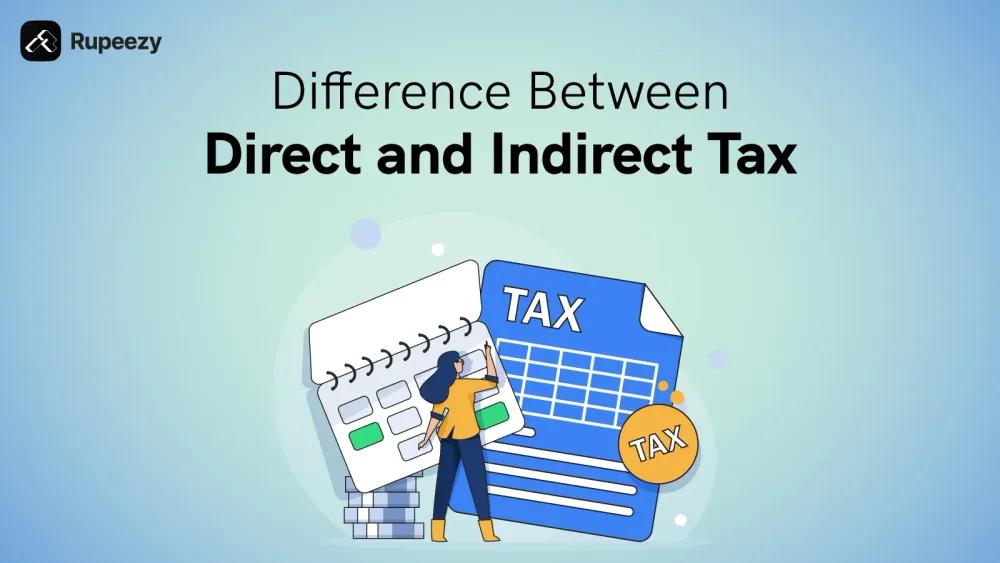Difference Between Direct and Indirect Tax in India


00:00 / 00:00
A popular saying goes, ‘Death and taxes are inevitable. Don’t you agree? As citizens of the country, we are bound by law to pay taxes to the government. The government uses the funds collected from taxes for public spending.
Apart from income tax payable on an individual's salary or business income, there are taxes levied on goods and services we consume such as clothes, movie tickets, jewellery, house purchase, investments, restaurants, grocery items, luxury, and travel, etc. Therefore it is pertinent that we arm ourselves with knowledge about taxation, different types of taxes and current taxation policies.
In this article, we will look at the types of taxes and the difference between direct and indirect taxes.
What are Direct and Indirect Taxes?
There are mainly two types of taxes levied in India:
Direct tax
Indirect tax
Direct tax is levied on the income or earnings of an individual or corporation, whereas, indirect tax is levied indirectly on expenses.
Direct Tax
Direct tax is the tax that is directly levied upon the income or earnings of an individual or company. The responsibility of paying direct tax is upon the entity or individual on whom the tax is imposed. The liability can not be transferred to someone else. CBDT (Central Board of Direct Taxes) set up under the Department of Revenue is the statutory body that manages the administration of direct taxes such as income tax, corporate tax, etc.
Indirect Tax
Indirect taxes are a consistent and significant source of revenue for the government. While direct taxes are imposed directly on income and earnings, indirect taxes are collected through another entity or intermediary in between, such as retailers, service providers, etc. The tax liability is shifted from the retailer to the end user. Indirect taxes are managed by CBIC (Central Board of Indirect Taxes and Customs) under the Department of Revenue.
Difference Between Direct and Indirect Tax
Feature | Direct Tax | Indirect Tax |
Levied On | Income and earnings | Goods and services |
Payor | Individual, Corporation | End-User, Consumer |
Tax Rate | As per Income and Tax slabs applicable | Common tax for everyone |
Mode of Payment | Directly to government | Through an intermediary charging the tax |
Transferability | Cannot be transferred | Transferred to entities in the chain such as retailer, end user |
Nature of tax | Progressive (tax increases as income goes up) | Regressive (tax rate decreases as income increases) |
Types of Direct Tax and Indirect Tax
Now that we have understood the difference between direct tax and indirect tax, let’s explore the various types of taxes under each category.
Types of Direct Tax
Let us look at different types of direct taxes levied:
Income Tax
Income tax is levied on the income of an individual or corporation’s earnings during a particular period known as the Assessment Year. The income tax is levied as per Income Tax rules stipulated by the government.
Income tax is charged based on income tax slabs, different tax rates are applicable for different income slabs for the particular year. The income tax rate can also vary for certain categories such as senior citizens.
In every year’s budget announcement, the government declares amendments, if any, in income tax provisions. Income tax is calculated according to prevailing guidelines. Assessees need to pay tax in full and file an income tax return by a certain date every year. Any excess tax paid is credited back as tax refund.
There are certain deductions allowed in the Income Tax Act that the assessee can avail. For example, payments made towards pension funds are eligible for deductions under Section 80 CCC. Investments in ELSS (Equity Linked Saving Scheme) qualify for deduction under Section 80 C.
Invest in ELSS schemes with Rupeezy, save tax, and create wealth at the same time. Select from multiple schemes, analyse returns against risk, check portfolio overlap with existing schemes, all in one app.
Corporate Tax
Corporate tax is applicable for business entities filing income tax as a corporation/company. In India, businesses are required to pay taxes on the income earned in a year. The tax rate can vary if a company is incorporated outside India.
Company | Corporate Tax Rate |
Domestic Companies with a turnover of less than Rs. 400 Cr | 25% |
Others | 30% |
Foreign Companies earning royalty fees or fees for technical services | 50% |
Any Other Income | 35% |
Capital Gains Tax
Capital gains tax is applicable on profits earned from the sale of investments or property. Capital gains tax calculation varies according to the time for which the investment was held. There are two categories of capital gains.
Short Term Capital Gains Tax (STCG) is applicable when:
Equity investments are sold within one year of purchase.
Debt investments are sold within two years of purchase.
Property or gold investment is sold within two years of purchase.
When the above investments are sold after the mentioned time period, Long Term Capital Gains Tax (LTCG) is applicable.
From FY 24-25, the capital gains tax rules have been amended.
There are two holding periods: 12 months and 24 months to define short-term and long-term capital gains. The 36-month holding period has been removed.
The Short-Term Capital Gain for equity shares and mutual funds has been increased to 20% from 15%. Other financial and non-financial assets held for a short term (24 months) will be taxed at income tax slab rates.
The LTCG for all financial and non-financial assets for FY 20-25 will be 12.5% (up from 10%).
Invest in direct mutual funds from 40+ AMCs and 1500+ schemes with Rupeezy. DIY your mutual funds investments with simple app, advanced features, ready-to-implement analysis to make investing easy and pleasant.
Securities Transaction Tax (STT)
STT is levied on every purchase and sale of securities listed on Indian stock exchanges.
Check https://rupeezy.in/pricing for STT and pricing. Download Rupeezy stock investing app, buy stocks, invest in IPOs, trade in derivatives and commodities all in a single app. Trade smart with advanced trading features, Basket Order, GTT-OCO Orders, Trade from Charts, Options Chain, Trading View and more.
Types of Indirect Taxes
There are different types of indirect taxes in existence:
Goods and Services Tax (GST)
GST introduced in 2017 is a unified tax structure that eliminates a complex indirect tax system in existence previously with multiple layers of taxes imposed at various points leading to tax on tax regime. The fragmented system also created inefficiencies, corruption and barriers to the free movement of goods across states.
GST has simplified taxation with a uniform tax across the country. Prior to GST, there were multiple taxes payable such as:
Excise Duty
Service Tax
Sales Tax
Value Added Tax (VAT, State)
Customs Duty
Octrio
Entry/Exit Tax (State)
GST Features:
One Nation, One Tax: GST removed multiple taxes levied at various points by State and Central governments, thus bringing unified tax and eliminating duplicity.duplicity.
Integrated Tax: GST includes State GST (SGST) Central GST CGST and Integrated GST (IGST) for interstate business.
Input Tax Credit (ITC): Assessees can claim taxes already paid on inputs to avoid multiple taxation.
Exemptions: Small businesses and service providers with annual turnover below Rs 40 lakhs are exempt from GST. Certain sectors such as healthcare have lower GST rates.
Digitisation: GST compliance is simple and transparent. GST registration, payment, and credits are executed via digital portals which have enhanced ease and compliance and curbed evasion.
Direct Tax vs Indirect Tax: Pros and Cons
Benefits of Direct Tax
Progressive: Direct taxes increase as earnings increase and thereby ensure economic parity. Direct taxes benefit the economy through higher tax collection and equitable distribution.
Economic Benefit: Direct taxes are a source of income for the government which in turn invests the funds in building public services and infrastructure. These investments fuel economic growth, employment, and fiscal stability.
Managing Inflation: Governments can impose higher taxes to control inflation by controlling the supply of money in the economy and curtailing demand, thereby, reducing prices.
Disadvantages of Direct Tax
Tax Evasion: Many individuals employ unscrupulous methods such as non-disclosure of full income to evade taxes despite vigilance and various measures taken by authorities to curb tax fraud. This leads to a loss of revenue for the government and discourages honest taxpayers.
Financial Burden: Direct taxes can be a burden on household budgets as income tax is deducted at source, or, a large amount is payable at one go. In an inflationary economy, progressively increasing taxes impact taxpayers with monetary load, complex rules, and paperwork.
Discourage Investments: An increase in direct taxes can impact disposable income and propensity to save and invest. Taxes such as capital gains from investment in shares, bonds, real estate, etc. can discourage investors from making large investments.
Benefits of Indirect Tax
Uniform Tax Rate: Indirect taxes are the same for everyone using common goods and services, there are no differential rates and the net is wider for tax collection. This ensures every consumer irrespective of income or eligibility is making tax contributions.
Automatic Process: Indirect tax collection does not require voluntary tax filing or any paperwork, the tax collection process is automatic and convenient, thus the collection is wider and easier.
Small Contributions: Indirect taxes are collected in small amounts on every purchase of goods and services. There is no one-time large payment required, this makes it easier for end users to make tax contributions.
Mandatory Tax: Evasion of direct tax is not possible as it is pre-levied on every purchase made, hence unlike direct taxes, there is no possibility of tax evasion or fraud.
Disadvantages of Indirect Tax
Price Increase: Indirect taxes can lead to an increase in the price of goods and services. For example, luxury goods, consumer durables, small cars, etc. attract 28% GST.
Regressive Impact: Indirect taxes affect low-income groups more than high-income ones. Low-income households end up spending a larger share of their income on indirect taxes levied on goods and services due to a common rate of tax for all.
Industry Impact: Indirect taxes can impact the industry negatively as raw materials are also under indirect tax purview. Higher prices can restrict businesses and manufacturers by impacting cost and profitability.
Conclusion
To conclude, direct and indirect taxes play an important role in the growth of the economy and form a major source of revenue for the government. As responsible citizens, we must be aware of our tax liability, the difference between direct tax and indirect tax and various taxes levied on earnings as well as goods and services. Also, individuals can take advantage of tax deductions available under income tax provisions.
Invest in top mutual fund schemes through Rupeezy. Select top performers in a click and set up lumpsum investments or SIPs. Use data analytics features and select the best funds for your investment goals.
FAQs
Q1: What is an example of indirect tax?
Goods and Services Tax, Service Tax, Value Added Tax, and Customs Duty, all are examples of Indirect Tax.
Q2: Who is liable to pay direct tax?
Individuals and corporations are liable to pay direct tax e.g. income tax or corporate tax as per their income and applicable tax rates on or before the tax due date.
Q3: What is an example of direct tax?
Income tax is an example of direct tax. Every individual is required to pay income tax on the income earned through salary, investment gains, interest received from banks, rental income, and income from other sources.
Q4: What is the difference between direct and indirect taxes?
Direct taxes are required to be paid directly to the government by the assessee such as individuals or corporations whereas indirect tax is paid to intermediaries for goods and services purchased.
Check Out These Related Articles |
The content on this blog is for educational purposes only and should not be considered investment advice. While we strive for accuracy, some information may contain errors or delays in updates.
Mentions of stocks or investment products are solely for informational purposes and do not constitute recommendations. Investors should conduct their own research before making any decisions.
Investing in financial markets are subject to market risks, and past performance does not guarantee future results. It is advisable to consult a qualified financial professional, review official documents, and verify information independently before making investment decisions.

All Category










